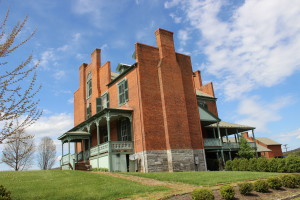 2015 marks an important anniversary for Southwestern Virginia, as its flagship county of Wythe (pronounced “With”) will be celebrating its 225th birthday.
2015 marks an important anniversary for Southwestern Virginia, as its flagship county of Wythe (pronounced “With”) will be celebrating its 225th birthday.
In addition to being the most trafficked Virginia county west of Lexington and Lynchburg, the Old Dominion locality is uniquely situated at the epicenter of almost everything – being midway between Roanoke and Bristol, Charleston, West Virginia, and Charlotte, North Carolina, and the Canadian border and Florida line.
Thanks to Interstates 77 and 81, which crisscross the county, the rural Virginia community which proudly boasts of 2.5 cows per citizen is surprisingly modern and charming – enjoying more than 75,000 vehicles passing through the area each day.
Its prime location puts it within a tank of gas of more than half the American population, which has equated to big business for its tourism industry. According to the Virginia Tourism Corporation, travel spending in Wythe County rose to more than $133.4 million in 2013, just behind the much larger western Virginia localities of Roanoke and Roanoke County.
In addition to the county’s key central location, Wythe has also begun to catch the eye of history enthusiasts – being the home to dozens of rich historical landmarks.
The county’s Austinville community once served as the county seat for the ginormous County of Fincastle, an extinct Virginia county whose borders stretched from Roanoke, Virginia, to the Mississippi River – a county roughly the size of half the State of Texas.
Speaking of Texas… and Austinville… Wythe County is also the birthplace of Stephen F. Austin, a man who left his boyhood home on the banks of the New River and founded the Lone Star State. Wythe County’s native son enjoys the title “Father of Texas.”
Austinville, however, was not named for Stephen, but rather for his father, Moses. Moses Austin helped establish that community while serving as an early pioneer in the locality’s lead mines.
A Stephen F. Austin birthplace memorial sits on the south bank of the New River, in the community of Austinville, a tribute to the Wythe County resident who changed the course of world history. Down the road just a mile or so is a granite monument which marks the site of the old Fincasatle County Courthouse (Austinville Rd., about .01 miles southeast of an intersection with Walton Furnace Rd.).
It was at this spot that delegates drafted the Fincastle Resolutions on January 20, 1775, stating their local grievances against the British government and boldly declaring to “never surrender their rights and privileges,” more than a year and a half before the Declaration of Independence was issued.
The county is home to dozens of other historical sites and places of interest to the lover of history, as well as awesome places to take a cool “selfie.” These sites include the birthplace of First Lady Edith Bolling Wilson, a woman critics chide as being “the first woman president,’ the grave of Dr. Charles T. Pepper, the reported inspiration for the popular soft drink which bears his name, and Rural Retreat, Virginia, the highest elevation on the Norfolk Southern Railroad between Norfolk, Virginia, and New Orleans.
In December of this year, local residents opened the Bolling Wilson Hotel, rated Five-Stars by TripAdvisor, the newly renovated inn dates back to the late-1920s. Just across the street is the Edith Bolling Wilson Birthplace Museum, a foundation dedicated to preserving the legacy of one of America’s most talked about first ladies; just a few feet away is the historic Skeeter’s “World Famous Hotdogs.” According to the sign painted on the side of Skeeter’s building, they’ve sold over 9 million hot dogs since opening their doors almost a century ago.
Other places of interest include a Virginia Civil War Trail driving tour, which begins at the top of Big Walker Mountain and follows the path of Federal soldiers who attempted an ill-advised raid upon the proud people of Wythe County in July of 1863.
A hastily organized militia succeeded in repelling the advancing Union army whose intention was to destroy telegraph lines and nearby salt and lead mines. In the battle, the defenders of Wytheville killed the Federal raiding party’s leader, Col. John Toland.
Time would fail us to mention the county’s shot tower which is the proud centerpiece on the county’s official seal. Built either in the late 1700s or early 1800s (it just depends on who you ask), the Jackson Ferry Shot Tower is a 75-foot tall structure that manufactured lead shot for early pioneers and settlers in the region – it is not an overstatement to say that this structure helped win the West.
To put it mildly, if you like history, then you’ll love Wythe County, Virginia! As one local resident stated, “We’re the Williamsburg of Western Virginia.
